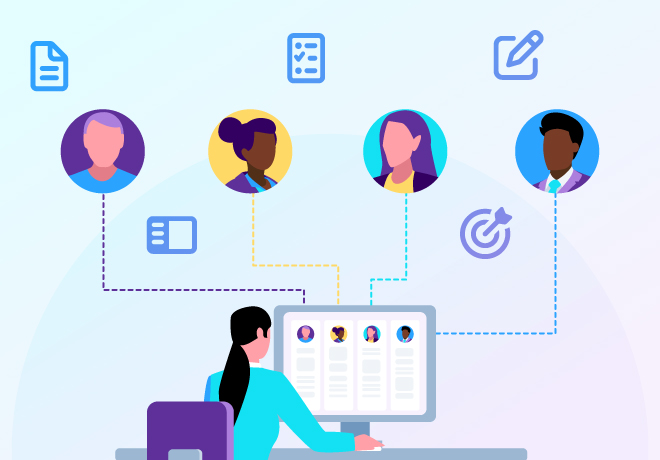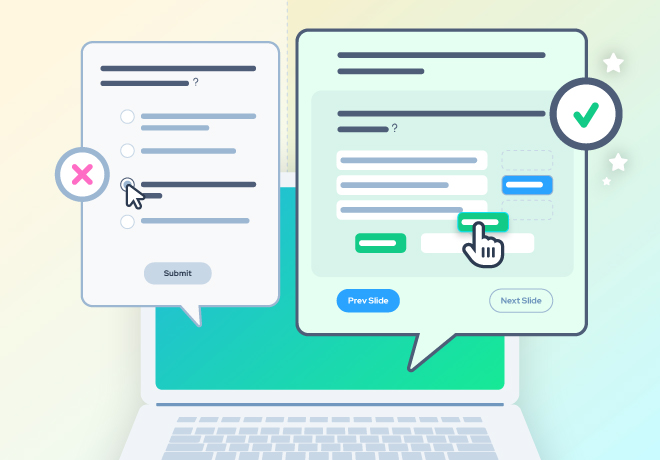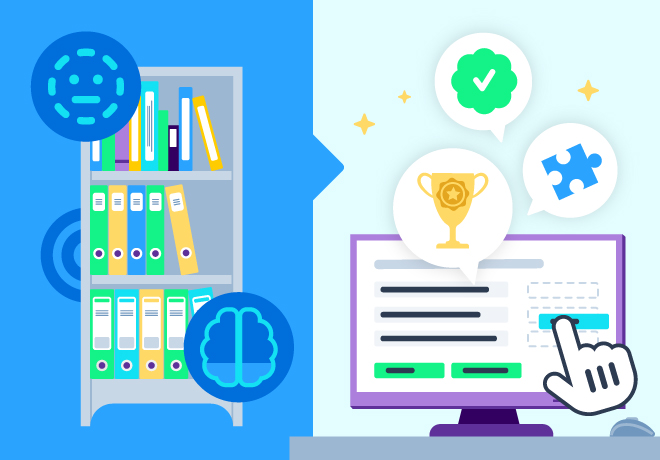
6 types of employee training you can deliver online

Related articles
Get valuable eLearning insights to your inbox.
Listen to Neovation’s Demystifying eLearning podcast generated with NotebookLM!
Listen to our podcast on your favorite platform!
Did I hear you say, “What types of training can I deliver online?”
Oh, how hard it is to resist answering a question with a question. What types of training can you deliver online? What types of training do you NEED to deliver online? And the answer is “lots.”
Thank you for coming to my TEDtalk.™
Hope that brought a smile to your face.
But seriously, it is a very good question, and the answer really can be that simple. You can deliver almost any kind of training you need online. Here’s a high-level overview of the various kinds of training that can be delivered using online tools, including:
- Orientation and onboarding training for new hires,
- Everboarding for things like refresher training or health and safety training,
- Reskilling and upskilling training for your existing employees,
- Training for hard skills, such as product knowledge or compliance training
- Training for soft skills, like coaching or mentoring, and
- On-demand learning with performance supports, in the form of knowledge bases, glossaries, and more,
- Plus, the kinds of training that can’t be delivered online.
Note that these are not “modes” of training – meaning the tools themselves, but the types/topics/themes of training that you can deliver online.

Orientation and onboarding
Orientation and onboarding training set the tone for what it’s like to work for your company and set expectations about how well-integrated and supported that new employee is going to feel about working for you and with your team. In my article, What is employee onboarding?, I go into great detail about how and why a thorough onboarding program is essential to employee success and how it has an impact on your company's bottom line. Some companies even start their online employee onboarding in the time gap between job acceptance and the first full day of work to help new employees start strong (you should compensate your new hire for the time it will take to do that training.) Onboarding topics can include:
- How to complete hiring paperwork, timecards, expense reports, etc.
- How to enroll in benefits and pension plans
- Location of first aid kits, fire extinguishers, and emergency exits
- Introduction to the team – using short bios, photos, or video introductions.
- Company culture, guidelines, and best practices
- Industry glossary
- Health and safety regulations
- Equipment manuals and instructions
- Job-specific hard and soft skills
- Standard Operating Procedures for any shared processes
- And more!
Everboarding
Once an employee has been around for a while; you can anticipate that the retention of their onboarding training will fade over time. There may be topics within their training they infrequently do – like filling out an expense report. Continuing to use refresher training, often delivered via microlearning platforms, makes it easier to recall useful and important information that may be needed less often than information they need for their day-to-day tasks. Health and safety training is another great opportunity for everboarding and any updated policies, procedures, and best practices that require consistent recall for compliance audits.
Company culture
Company culture is a mixture of soft and hard skills. Employees usually get most of their cultural training as part of their onboarding process; however, many companies are everboarding their company culture modules to ensure that company values, procedures, and guidelines are incorporated into their team’s everyday awareness.
Reskilling and upskilling
I’m putting these two together as they are often used interchangeably unless your company has specific definitions based on your team’s roles, requirements, and succession planning policies. Reskilling involves teaching learners new skills to prepare them to take on new responsibilities or change roles within the organization. Sometimes, it becomes “remedial reskilling” – where a learner needs to revisit previous training to bring their job performance up to the expected level before being considered qualified to apply for advancement. This can also tie into Compliance and Certification Training (see below).

Upskilling, on the other hand, more often refers to teaching your team new skills so they can adapt to changes in the roles that they are already in. These changes can be based on new technologies, automation, policy, or procedure changes – anything that causes there to be a change in the skills needed or workflow being followed.
See our article, What is reskilling and upskilling?, where we go into more detail.
Hard skills
This term gets tossed around a lot, and I once had someone ask me, in all seriousness, if that meant it was hard to learn the skill being taught. I understand why they asked that question. Hard skills are skills you can prove you have, demonstrating that you have the factual knowledge or technical ability to “do the thing.” Many hard skills can be taught online, often using animations, simulations, and augmented reality to deliver the course content that teaches the necessary skills.
An example is an online typing tutor. I personally like the game-based ones, like TyperShark, if it's still around. But even more straight-up typing tutor programs measure your typing speed and accuracy and give you hard numbers to improve upon. Another example would be matching labels to the parts of a machine – you either know your thing-a-ma-bob from your whatchamacallit, or you don’t. Or maybe it's a whatsitsname? Drop the right label on the right component and see your score.
Products and services
If your company sells physical products, your sales and service teams need to know the features, benefits, and functionality specifications of everything you sell. Product lines can change, can become “new and improved,” and it can be hard for the team to keep up. Then there are the products that are sold more infrequently, where the information may not be top of mind. Ongoing retention training across your entire product offering for your sales and service teams ensures that the hard skill of factual product knowledge is always at the standard you need to build your business.
Compliance training
Online training delivery can revolutionize how you deliver your compliance training. Historically, learners go through some form of annual refresher training, often stepping away from their work to take a course they may have taken every year to check a box, pass an exam, and retain their compliance certification. That doesn’t mean that the knowledge is being retained or used consistently during the work year.
Online training platforms, and in particular, microlearning platforms, allow you to deliver your annual compliance training on a daily basis. Learners retain their knowledge and can apply it because they remember it. This training becomes part of their daily routine, taking only minutes a day and removing the need to pull workers away from their work at “compliance time.”
When the compliance regulators come to call, you will have hard data from your platform’s analytics that will show that the material was reviewed and that knowledge gaps were closed during the year. Ongoing refresher training for compliance standards can ensure that 100% of the material gets reviewed.
Soft skills
Online training is also a great way to build soft skills – those character traits and interpersonal skills that characterize a person’s relationship with other people. How can a computer teach soft skills? Simulations that mirror real-life scenarios (i.e., scenario-based training) will allow the learner to “choose their own adventure” and learn which skills bring the best outcome and a passing grade. Good manners and professional communication are equal parts learned behavior and habit – and having a memory bank full of best answers and right responses to work-related scenarios will improve soft skills over time.
Coaching and mentoring

Good coaching and mentoring are all about transparency and oversight – in a good way. Online training technology gives your corporate coaches immediate insight into every learner’s current performance, accomplishments, and challenges. Learners can be automatically assigned to new learning paths to enhance their training as part of their professional development. Online meetings can be recorded and documented by including the recording in the learner’s knowledge base or file system, where they can access it on demand after the call happens, along with new or additional resource documents that the learner may need to support their performance improvement.
Performance supports
Performance supports are known by many names, including a knowledge base, a resource center, a learning hub, a document repository – all names for the place where files are stored online within a training management system for easy learner access.
Having immediate access to whatever references they may need to do their job is of key importance to your employees. Performance supports can be as simple as a glossary with a search bar or as complex as a detailed multi-page product manual.
A good learning platform will allow you to store all kinds of files within it, should be searchable, and have a permissions structure, to ensure that the right people have the proper level of access to materials. Ideally, these resources would be available on mobile devices like cell phones and tablets to allow your learners to answer their own questions and reinforce learning wherever they are.
Digital performance supports can be easily updated, so every employee always has access to the current version of the information they need – no more outdated binders on dusty office shelves or multiple outdated PDFs squirreled away on countless hard drives. Having one source of digital truth reduces stress, conquers the misinformation monster, and saves your team time every time they need to look something up.
What kind of training can’t be delivered online?
Depending upon your industry, there may be types of training that will not translate well or be affordable when delivered online.
When hands-on training makes sense
An auto-worker can learn the safety requirements, the workflow, and the step-by-step process he will need to follow but will ultimately need to be trained in real-time by experienced professionals on the job. Online training can supplement but not replace that experience. Medical simulations allow surgeons to practice a new procedure a thousand times before they touch a medical cadaver or living patient – but I want them to have done the procedure on that cadaver a few dozen times before they cut into me.
It can be difficult or expensive to create a complex enough simulation to teach psychomotor skills, ones that are learned under supervision and require access to specialized tools in a controlled environment. Face-to-face training, job shadowing, and on-the-job training allow for the organic experience of traditional training to develop those critical skills. These skills can be supplemented by online training, but online training will not be the only training that is needed. This model is called hybrid training or blended learning.
Online training – the future is now
If you’re asking about what types of training you can deliver online, my bet is that you are thinking about moving your current training to a blended or fully online offering. That’s great! Your next step will be to do a training audit to sort out what you already have for training materials, where the strategic and knowledge gaps are, and to formalize your transition plan.
I’ve written two articles that will help you – What is a training audit? and How do I perform a training audit? – that will get you started. Alternatively, if you’re still putting your training program together, refer to our introduction to online training guide, which covers basic types of training, advanced formats and concepts, and everything else in between.
As long as you keep your training outcomes in mind and ensure that you are using in-person or on-the-job training only where it makes sense, you’ll be able to experience the many benefits of online training – no matter what type of training you want to offer your team. Good training starts on Day One and continues throughout your learner’s tenure – ensuring they are always engaged in building skills and increasing their job satisfaction – giving your organization the competitive edge of a skilled and engaged workforce. Isn’t that the future you want for your company?

With 15+ years of online marketing and online learning experience, Susan loves to share insights about where these two ROI-building practices can intersect and complement each other for your business or organization.
Become part of our L&D community
We publish a new learning hub article — full of useful, practical topics — weekly.
Not sure where where you want to start? Jump into one of our recently published articles and see where it takes you!








-svg.svg)
-svg.svg)
-svg.svg)
-svg.svg)